How to MIG Weld Cast Iron: And How to Skip Preheating
MIG welding (or GMAW) is easy to use, and many new welders wonder how to weld cast iron with it. After reading this article, you will learn about what settings, wire, and gas you need and the steps you must follow.
Cast iron is tough to weld because it is brittle, and rapid expansion or contraction caused by welding heat can crack it. Therefore, avoiding putting high amounts of heat at fast rates in the casting is of utmost importance.
Weldpundit already has an article on how to weld cast iron for beginners with basic information.
Table of Contents
- What MIG settings do you need for cast iron?
- 1. Identify the cast iron alloy
- 2. Clean the surface
- 3. Prepare the casting
- 4. Preheat the casting to avoid temperature differences
- 5. Weld short beads to prevent uneven temperatures
- 6. Peen each bead to prevent shrinkage stress
- 7. Post heat the casting to fix temperature differences
- 8. Protect the casting so it can cool down slowly
- How to MIG weld cast iron without preheating
- An alternative to fusion welding
What MIG settings do you need for cast iron?
First, you almost always want to weld cast iron using the short-circuit metal transfer mode. This mode gives good results because it generates low heat that:
- Creates a small arc with low penetration.
- Creates a narrow heat-affected zone (HAZ), reducing the chances of cracking. The HAZ is the area next to the bead and is where most of the cracks appear.
- Prevents too much carbon and other impurities from entering the puddle.
Short-circuit is the mode most low-amperage MIG machines offer.
The spray transfer mode that high-amperage machines can also support is not suitable for most cast-iron work. That’s because it is too hot and aggressive, increasing the risk of cracking.
For cast iron, you always set a slower wire speed and voltage than equivalent steel welding. Cast iron needs a smaller arc that will slightly melt the surface and achieve superficial fusion.
Furthermore, when you use preheating, it’s like welding with higher amperage. If you set typical wire feed and voltage, you will overheat the casting.
Of course, you must not set the heat too low. The puddle must be easy to control and fill the edges.
If the settings are too low, the short-circuit mode might melt the wire but not the casting. This will create a superficial weld without strength. You can weld on similar scrap iron, cut it and check the depth of fusion.
Since you use nickel wires for cast iron, you must refer to their packaging or the manufacturer’s site for the recommended wire feed speed and voltage. These settings are not the same as typical wire. They will also mention the gas type you need.
Pushing the MIG torch is better for improved gas coverage and lower penetration.
Modern MIG machines support the synergic feature. It auto-adjusts the wire speed and voltage after you input what wire you will use and the base metal type and thickness. Other machines can output pulsed current to achieve penetration with less heat. These make welding cast iron easier.
What MIG wire is the best for cast iron?
The best MIG wire for cast iron is the nickel-based ERNiFe-CI (or ERNi55). This wire has high tensile strength and ductility. It can weld most ductile irons, dirty castings, cast iron to steel, and the weld metal has good machinability.
After that, you can use an ERNi-CI (or ERNi99) wire that is always machinable but is somewhat weaker and more expensive. Machinability is how easy it is to drill and cut the weld metal.
Nickel-based wires are the proper consumables for all cast-iron types. These wires don’t shrink much and always offer ductile weld metal. They also resist carbon absorption. As a result, they lower the high cracking risk.
The ERNiFe-CI wire’s main elements are 55% nickel (Ni) and iron (Fe), with a small amount of various other elements. It is superior in every way to the ERNi-CI except machinability.
The ERNi-CI is almost pure nickel. Use it when you want 100% machinable weld metal. But it doesn’t have tensile strength high enough to weld most ductile irons. Also, it cannot tolerate high amounts of sulfur, phosphorous, and other impurities in low-quality castings. These impurities cause hot cracking when the bead cools down.
Another wire you can use is the ERNiCu that contains copper (Cu) instead of iron. It offers higher ductility and corrosion resistance but may absorb carbon. Ensure the lowest possible penetration to avoid this because carbon and copper in the puddle lead to hot cracking.
The proper nickel wire will give you sound welds that will last for a long time, even if the casting’s service conditions are demanding.
However, there is a significant disadvantage, nickel wire costs a lot of money. A two-pound (900gr) nickel-iron spool costs at least $100.
To make things worse, these wires need 75% argon and 25% helium shielding gas to offer good results with the short-circuit transfer. You must also set a higher gas flow rate compared to mild steel flow rates.
However, you can also use the tri-mix gas (90% helium – 7.5% argon – 2.5% CO2) for stainless steel if you already have one.
The different gas cylinder adds additional cost, time, and effort.
Nickel wire is expensive for home usage since you only need a small quantity to repair castings. But it is wise for professional work since repairing cast iron has a high return on investment (ROI).
With the proper nicker wire, preheating isn’t necessary for simple welds. That makes things simpler and cheaper. But if you have a large or complicated casting, or it’s restrained, use preheating.
Another nickel wire you can use is the ERNi-1. It has a similar composition to the ERNi-CI and is made to weld nickel alloys. It will shrink a bit more and has lower ductility. But it is much better than the remaining options. ERNi-1 needs 100% argon shielding gas.
If you want to avoid these costs, stick welding cast iron is a cheaper alternative. But you must have some experience with this process first.
Can you weld cast iron with mild steel wire?
It is possible to MIG weld cast iron with mild steel wire such as the ER70S-6 for light repair work. However, it isn’t recommended for critical welds. The deposited metal will absorb carbon from the casting and become too hard and brittle. It will also shrink a lot. Even if the weld holds for now, it is very likely to fail under pressure or vibrations.
Since nickel wire is so expensive, and you need a different gas, using mild steel wire is tempting. Many welders repair small castings using common steel wire.
Still, it’s not wise for critical welds, expensive or irreplaceable castings. It will never have the reliable, long-lasting results of the proper nicker wire and gas.
If you want to try, use the 75% argon and 25% CO2 (or C25) gas, since it offers lower penetration than pure CO2. Furthermore, steel wire needs much higher preheating, something that will add to the final cost.
You also need to have some experience in cast iron welding. You need to follow all the steps correctly without mistakes.
Also, the weld metal will not be machinable. It will be impossible to drill or cut it. Furthermore, the bead may be hard to grind, depending on how much carbon is absorbed.
Can you use flux-cored wire for cast iron?
With a MIG welder, it is possible to weld cast iron using the Ni55FC flux-cored wire. It is similar to the ERNiFe-CI. Unfortunately, this wire doesn’t weld thin castings, is rare to find small spools, and is very expensive. Most often, it is not self-shielded but requires additional shielding gas.
In a nutshell, flux-cored welding with nickel-based wire is meant for professional work. Most spools are big and more expensive than many home MIG machines. It is hard to find 2-pound spools, and they probably will cost $150 or more.
If you find one, read the instructions for the proper serrated rollers and polarity.
Using self-shielded steel wire such as the E71T-11 has the same disadvantages as ER70S-6 wire, plus the inability to weld thin castings.
However, the flux material inside the E71T-11 will leave a slag covering that acts as insulation and delays the cooling rate. This will somewhat make the weld metal less brittle and give you more time to peen the bead.
In the second part of the article, let’s see how to MIG weld cast iron with preheating step by step.
1. Identify the cast iron alloy
Almost certainly, you have gray iron, since it is by far the most common type. But you may have nodular or malleable iron. These two have some degree of ductility (how much they can bend without breaking).
Weldpundit already has an article about how to identify metals, but here are the basics to figure out the casting you have.
A spark test is an excellent method to identify metals, but you must have identified sample metals to compare them with your workpiece. In a nutshell, gray iron has short and reddish sparks, but ductile irons have longer and yellowish sparks, similar to steel sparks.
If you have a broken part, gray iron has a characteristic dark-gray color. Malleable iron has a white, steely surface, but gets gray towards the center. Nodular iron’s color is more similar to gray iron.
You can distinguish gray iron from ductile irons by testing their hardness:
- You can use a center punch and a hammer on them. If the crater has a smooth surface, it is gray iron. If the crater has a burr, it is a malleable or nodular iron.
- You can also try to drill the casting. If the chips are like powder, it is gray iron. If they are somewhat continuous, it is ductile iron.
- If the chips are long and very ductile, you may have cast steel rather than cast iron.
If you cannot drill the casting, it is hardened by the manufacturer or by former welding. If so, it is too hard to weld it with success. However, if it is localized, then you can remove the affected area.
Since gray iron is the most popular, the rest of the guide will be about it.
2. Clean the surface
MIG needs clean joints to offer good welds. Dirt will restrict the weld metal’s fluidity and contaminate it, resulting in defects such as undercut and porosity.
Furthermore, hard-to-weld metals always need a clean surface to reduce the risk of failure, and cast iron always has impurity problems. Oil and other contaminants may cover the surface. Because cast iron is porous, oil can penetrate the surface.
If the casting has absorbed oils, acetone, and similar products will not be effective. Use a mild brake cleaner that does not contain chlorine. The welding heat and ultraviolet rays convert chlorine to hazardous gases.
Read the product’s description to verify that it is not chlorinated and the how-to-use instructions.
The trade-offs of nonchlorinated products are that they are more expensive and very flammable.
You can also remove residual oil by preheating the casting to 750 °F (400 °C) for 15-30 minutes, but it’s costly.
If your casting is free from oil, you remove the casting skin, rust, paint, etc. You can use various ways, such as sandblasting or grinding. If you use an angle grinder, don’t focus on one spot to avoid discolorization.
Grind both sides at least 1″ (2.5 cm) to bright metal to prevent impurities from entering the weld metal. The arc will also start easier and run smoother. After grinding, use a file to remove residual carbon on the joint.
A technique to test for trapped contaminants before welding is to pass a small 1/2 – 1″ (12.7 – 25.4 mm) low-amperage stringer bead on the surface close to the repair area.
Then grind the bead to the same level as the casting. Now you check the clean bead for porosity. If there is porosity, the casting is still contaminated, and you will have problems throughout the entire weld. Before you continue, you must thoroughly clean the joint.
3. Prepare the casting
The best way to remove a crack and prepare a cast iron joint is with a chisel and a hammer. This way, you keep the casting cold, avoid contaminating the porous casting with abrasives, do precise work, and it is safer than grinders.
After that, you can use a die grinder with carbide burrs or a small-diameter angle grinder, depending on the size and shape of the workpiece.
If you use an angle grinder, move it evenly over the area and avoid focusing on one spot. Grinding generates high amounts of heat that can affect the casting. When you finish, use a file to remove residual carbon and abrasive material on the joint.
Ensure that the groove will be as symmetrical as possible, and always try to weld in the flat position.
Removing cracks
Cracks on cast iron are the most common damage to repair. If you weld on a crack, the expansion and contraction forces will make it bigger.
To prevent propagating the crack:
- Drill two holes at least 1/8″ (3.2 mm) wide and 3/16″ (4.8 mm) beyond the ends of the crack.
- Then, remove the crack by creating a V groove at a safe depth, up to 1/8″ (3.2 mm) from the bottom of the crack, but no more than that.
- If possible, try not to leave an open root.
The deeper the joint is, the more weld metal you need to cover it. That will put more heat into the casting.
Broken parts
Because gray iron is rigid and brittle, broken parts fit perfectly with each other. Therefore, depending on the size and shape of the broken piece, you can:
- Fit and tack weld the broken part. After that, you can create a groove, just like when you fix a crack.
- Or you can create small 35-degree bevels on both parts to reduce the weld needed to fill the joint. Then tack weld the broken piece to the casting.
Since ordinary gray iron has low tensile strength and nickel filler metals are much stronger, you can avoid full penetration welds if the casting doesn’t have demanding service conditions.
Butt joints for cast iron
Now, let’s see the scenario where you have a typical butt joint, and your project needs full root penetration.
Since nickel wires don’t offer deep penetration, you leave a wider root gap than similar steel joints.
If you weld a square butt joint from one side and your workpiece is up to 1/8″ (3.2 mm) thick, you can leave a root gap half the casting thickness or even a little more.
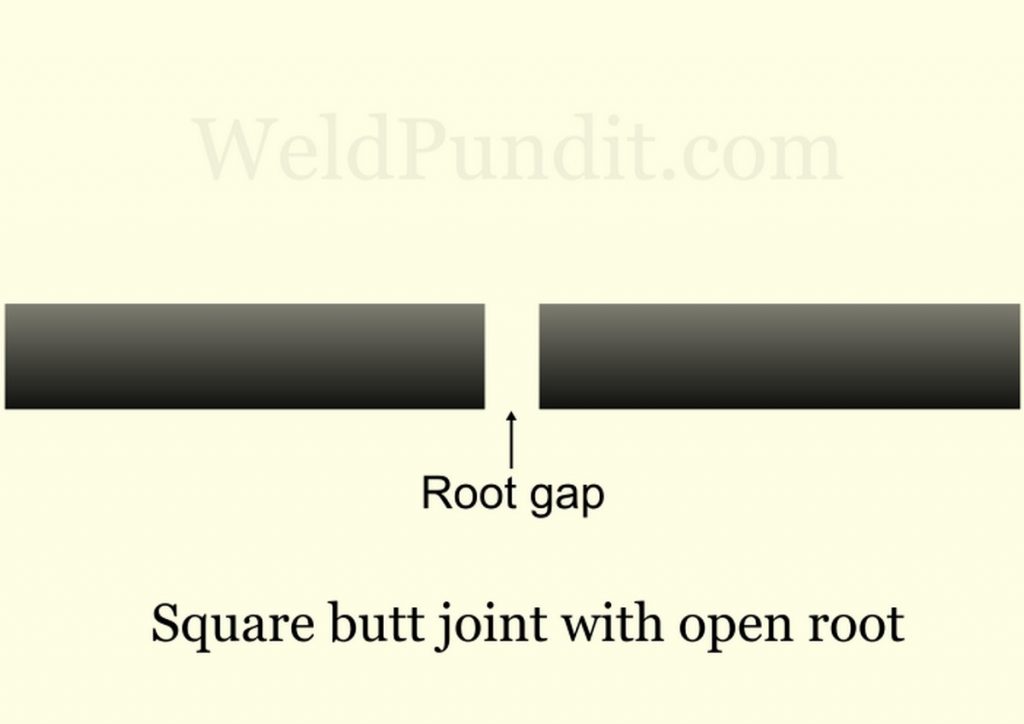
If you can weld from both sides, you can go up to 1/4″ (6.4 mm) and leave a root gap half the casting thickness.
If the casting is thicker than 1/8″ but cannot weld both sides, create bevels on each side and form a single-V groove.
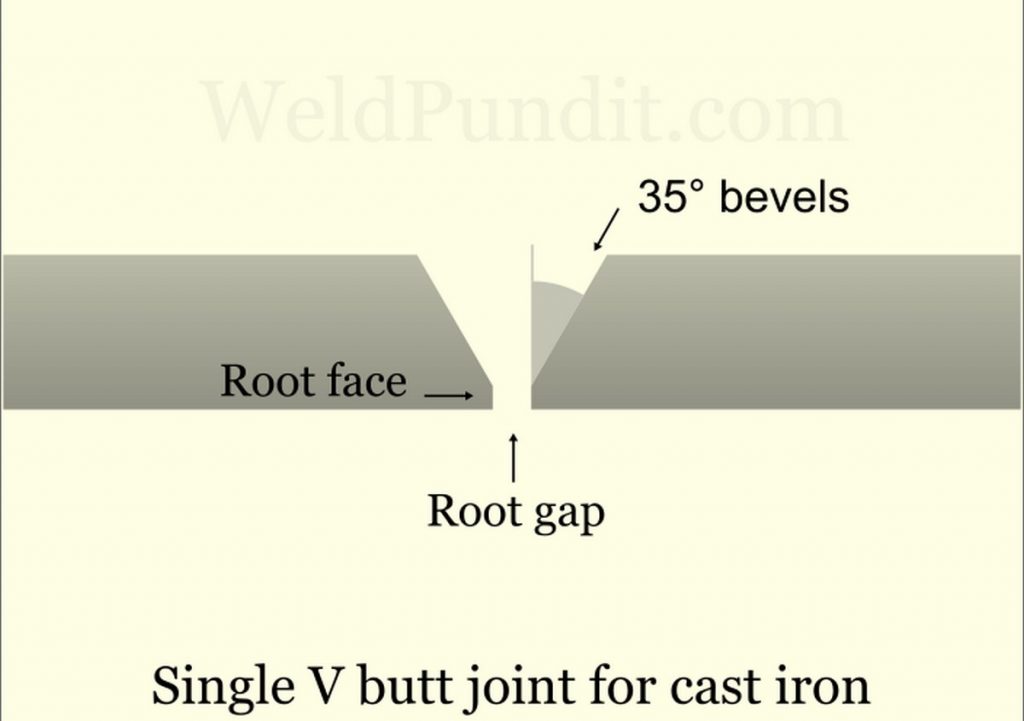
Because nickel weld metal is sluggish and doesn’t flow well, you create wider bevels than similar steel joints, at least 35 degrees on each side. This way, you have improved puddle control.
Furthermore, you don’t leave a thick root face because nickel wire cannot penetrate deep. Therefore, the root face should be no more than half the root gap.
If the casting is between 1/4″ and 1/2″ (12.7 mm), you always create a single-V groove. The root gap for this groove type is up to 1/8″. Again, the maximum root face is half the root gap.
For thickness greater than 1/2″, it’s recommended to use joints that require less weld metal and spread the shrinkage stress more evenly. This way, you save money since nickel wires are very expensive, and you lower the cracking risk.
A double-V groove is excellent if you can weld it on both sides.
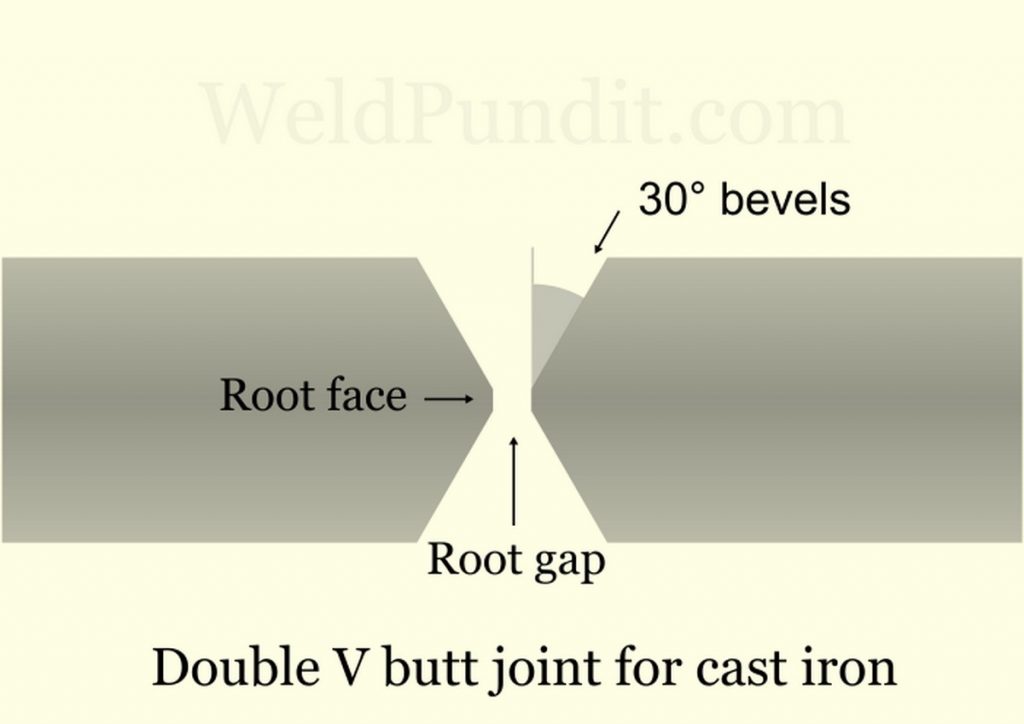
However, if you weld on one side, you want a single-U groove.
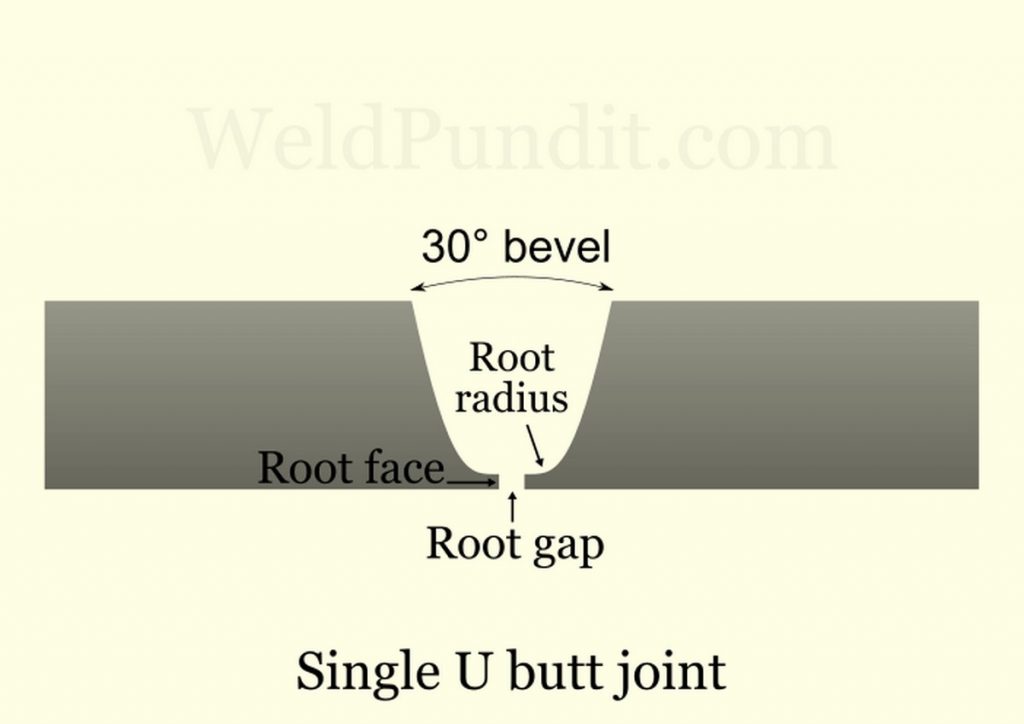
Double-U grooves are recommended for cast iron thicker than 3/4″ (19 mm).
U grooves are preferred for cast iron since they require less weld metal, have fewer sharp edges that concentrate stress, and are more symmetrical than V grooves. But you need slow and expensive machining methods to create them.
For the most common cast iron jobs, V grooves are good enough and easy to make.
4. Preheat the casting to avoid temperature differences
Preheating prevents fast expansion when you weld and quick cool-down after welding. It also prevents carbon migration in the weld metal. With preheating, you decrease the risk of cracking.
You can use an oven or a flame torch. The typical preheating temperature of medium-sized used gray iron is 500 °F (260 °C).
If you preheat with a flame torch, move it over the casting and concentrate on the thicker parts. This way, you preheat in an even way.
Occasionally use the temperature stick on the surface to check the temperature. If the stick melts evenly all over the casting, you are ready to weld. You can also use an infrared digital thermometer, but they are not as reliable, especially on shiny surfaces.
When you preheat the casting, you must weld it in a reasonable amount of time to prevent it from getting cold. If you use the temperature stick, and it doesn’t melt, reheat the casting.
You should avoid cold drafts during welding to protect the preheating temperature. If the casting is big, insulate it with welding blankets or similar equipment.
If you hear tinkling noises, it means the casting is cracking. Chances are you didn’t avoid the temperature differences with enough preheating.
5. Weld short beads to prevent uneven temperatures
When you weld brittle metal, you weld very short beads to avoid putting too much heat. The general rule is to weld 1″ (25.4 mm) beads. The length depends on the casting thickness:
- For a 1/4″ thick casting, you can weld a 1″ bead.
- For a 1/4 to 1/2″ casting, weld a 2″ bead.
- And for 1/2″ and thicker, weld a 3″ or slightly longer bead.
The heat input depends on the way you place the beads. To reduce the cracking risk, you don’t place each bead right next to the other. Instead, you spread them along the joint to spread out the heat.
Below is an image with an example of how to spread the beads on the joint.
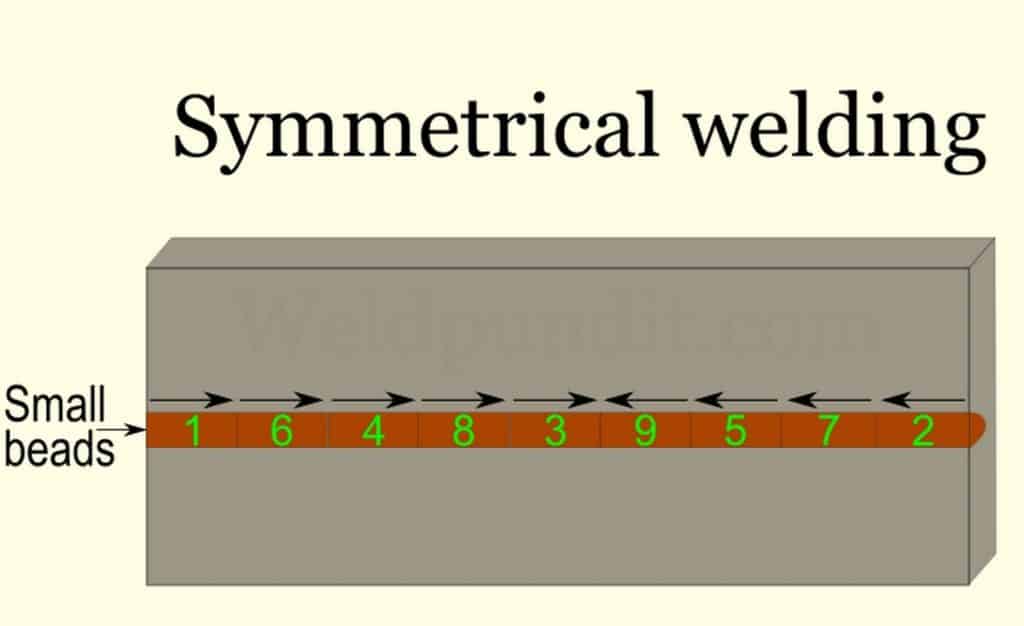
Some additional tips:
- The traveling speed greatly affects the heat input. For this, you should travel as fast as possible without creating any defects from it.
- Straight beads (or stringers) without weaving the MIG torch are more suitable.
- Each time you weld, you should avoid starting the arc on the casting, but in the joint or on previous beads.
- Always fill the crater. If there is a gap, the shrinkage forces can crack it.
- If a crack appears during welding, stop and drill holes at both ends to stop it from expanding.
- If your casting is irregular, weld the thicker areas first.
- Put the working (or grounding) clamp on the casting for a better connection. This is very important with MIG welding.
- Avoid drafts since they will displace the shielding gas. Nicker weld metal doesn’t wet out well, and lack of gas coverage makes it worse.
Avoiding turning red-hot the area you weld is a reliable indication that you do not overweld the casting.
6. Peen each bead to prevent shrinkage stress
Peening is when you tap all over the red-hot bead with a small rounded hammer immediately after welding it. Start from the crater and use rapid blows that will lightly indent the bead.
Peening will stretch the bead and counter shrinkage forces. This will prevent residual stress in the bead and will reduce the cracking risk.
Hitting the bead too hard or too long will harden it and make things worse. We call this work hardening.
You may also use a rounded chisel or an electric needle scaler with round needles.
7. Post heat the casting to fix temperature differences
After welding, you must ensure the casting has at least the same preheating temperature, spread out evenly. Check the temperature and reheat the casting if necessary.
8. Protect the casting so it can cool down slowly
The final step is crucial to preserve the metal’s characteristics and prevent cracking. The slower you cool down the casting, the better.
You must insulate the entire casting until it reaches room temperature, and you can touch it.
If you preheated the casting with an oven, use it again to cool it down. Otherwise, you can cover it with welding blankets, similar fiberglass material, or dry sand.
In the third part of the article, let’s see how to MIG weld cast iron without preheating.
How to MIG weld cast iron without preheating
There are many situations when you can skip preheating:
- Sometimes castings are too big or complicated to preheat correctly.
- The damage is short cracks or superficial wear.
- You might not have the necessary preheating equipment.
- You cannot dismantle the part, and it will crack if you preheat it.
- The casting is small and simple, and you want to avoid the trouble and the costs.
- You already have some experience welding cast iron.
You can MIG weld cast iron without preheating using nickel wires (ERNi99 and ERNi55), very short beads, and constant peening. Then leave each bead to cool before passing the next one. However, no preheating will always make the casting weaker next to the weld and more prone to cracking in the future.
Welding without preheating is also called cold welding. You also skip the post-weld reheating, and the casting’s slow cool-down. This will save you effort, time, and money.
The main concern is to minimize the heat input and the width of the heat-affected zone (HAZ) to the absolute minimum. To do this:
- Use only nickel wires made for cast iron.
- Use the slowest wire speed and voltage to melt the wire properly and achieve low penetration.
- Weld short 1/2″ (12.7 mm) to 1″ (25.4 mm) straight beads.
- Always peen the bead when it’s red-hot.
- After each bead, you stop and let the bead cool down until you can touch it comfortably with your bare hands. That’s around 100 °F (38 °C), but not lower. This step is the most important when welding without preheating.
- After that, you weld another short bead at a different spot on the joint and repeat the cycle until you finish.
However, skipping the preheating step doesn’t mean you can weld a cold casting. Welding in a cold environment will always give poor results. Instead, try to warm the casting to room temperature 75 °F (24 °C).
When you use the short-circuit mode without preheating, you risk having incomplete fusion with the casting. To fix this, you increase the wire speed and voltage.
Keep in mind that lack of preheating is risky, and you should consider preheating when:
- The casting is very thick.
- Has demanding service conditions.
- Is damaged in the center. Cracks or broken parts at the edges can be welded easier with less or no preheat.
Finally, let’s see a great alternative to join cast iron with MIG equipment.
An alternative to fusion welding
Ordinary welding penetrates the casting offering a strong joint, but you don’t always need that. As an alternative, you can use the braze welding method to repair or join cast iron.
Braze welding uses similar equipment as fusion welding but a different filler metal based on copper. The copper-based wire melts at a lower temperature than welding wires.
This method is far better to join cast iron since it releases a lower amount of heat thus a much lower chance of cracking. Braze wires are also cheaper than nickel ones and use 100% argon gas without helium.
The most popular braze wires are silicon bronze (ERCuSi or SiB) and aluminum bronze (ERCuAl). The ERCuAl has higher tensile strength, but it doesn’t wet out like ERCuSi.
These wires use 100% argon gas, but need U-shaped rollers and a teflon liner because they are soft. You can also use a spool gun if you have one.
Another pro is that braze welding needs even lower or no preheating at all.
Furthermore, modern MIG machines that support the synergic feature may have an option for braze wires. This will offer improved heat control, lowering the cracking risk even more.
Because braze welding does not penetrate the casting, it lacks the strength of fusion welding. It also has lower heat resistance. If braze filler metal heats up to 930 °F (500 °C), it will lose a lot of strength and will not be able to hold the joint. Therefore, it would be best not to braze weld projects that reach 400 °F (200 °C) or higher temperatures.
Furthermore, it needs perfectly clean metal to flow correctly, especially if you work with gray iron. Finally, braze weld metal always has goldish color.
Weldpundit has an article that discusses when it is better to braze or weld cast iron.
More Weldpundit articles
